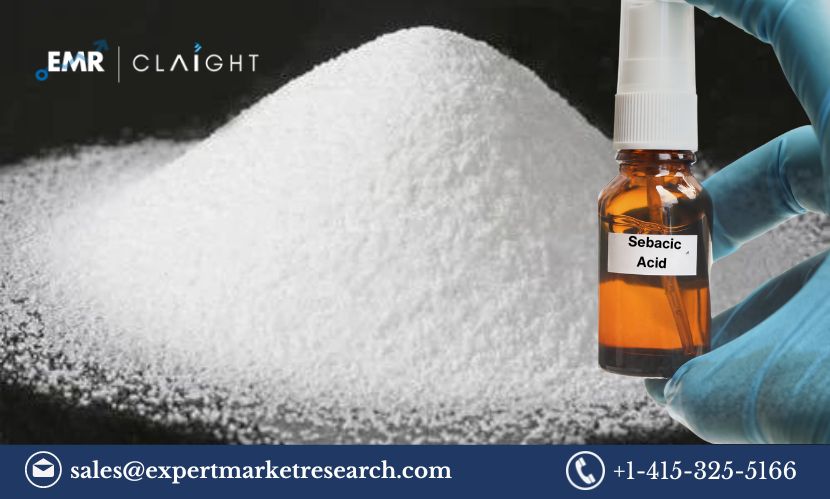Sebacic Acid Market Trends: Size, Growth and Forecast | 2025-2033
Sebacic Acid Market Outlook
The global sebacic acid market size reached a value of USD 286.30 million in 2024. The market is projected to continue its upward trajectory, growing at a compound annual growth rate (CAGR) of 3% between 2025 and 2033, ultimately reaching a value of USD 373.74 million by 2033.
Sebacic acid, a dicarboxylic acid derived from castor oil, is increasingly being used across various industries due to its versatile properties. It plays a vital role in the production of polyamides, lubricants, and plasticizers, making it a key ingredient in multiple sectors, including automotive, chemical manufacturing, and personal care. The growing demand for eco-friendly and biodegradable materials is one of the primary drivers behind the expansion of the sebacic acid market, as it is derived from renewable resources and is considered a sustainable alternative to petroleum-based products.
As the demand for high-performance polymers, biodegradable plastics, and specialty chemicals continues to rise, sebacic acid’s role in these industries becomes even more significant. The market’s growth is further propelled by the increasing use of sebacic acid in the manufacturing of bio-based polyesters and polyamides, which have applications in textiles, automotive parts, and electronics. This article provides a detailed overview of the global sebacic acid market, its key drivers, challenges, and future growth prospects.
Market Drivers
Increasing Demand for Bio-based Products: The growing demand for sustainable and bio-based products is one of the most significant factors contributing to the growth of the global sebacic acid market. Sebacic acid, derived from castor oil, is considered an eco-friendly alternative to petrochemical derivatives. With rising awareness about the environmental impact of synthetic chemicals and materials, manufacturers are increasingly shifting toward renewable and biodegradable alternatives like sebacic acid.
Sebacic acid’s use in the production of bio-based polyamides and polyesters, which are often utilized in the automotive and textile industries, has made it a preferred choice for companies looking to meet the increasing demand for sustainable products. The use of sebacic acid in polyamide 610 (a bio-based polymer) and other bio-plastics is growing, especially in automotive and construction sectors where there is a rising emphasis on reducing the carbon footprint and improving the sustainability of materials.
Expanding Applications in the Automotive Industry: The automotive sector is one of the largest consumers of sebacic acid, primarily due to its role in producing high-performance polyamides used in car parts and components. Polyamides derived from sebacic acid exhibit superior mechanical strength, thermal stability, and resistance to wear and tear, making them ideal for use in automotive applications, including under-the-hood components, fuel lines, and electrical connectors.
As the automotive industry continues to advance toward lightweight and durable materials for improved fuel efficiency and lower emissions, the demand for sebacic acid-based polyamides is increasing. Additionally, the growing trend of electric vehicles (EVs) is also expected to drive the demand for sebacic acid, as these vehicles require advanced materials with excellent performance characteristics.
Rising Demand for Biodegradable Plastics: The push towards sustainability and environmental consciousness is fueling the demand for biodegradable plastics, where sebacic acid plays a pivotal role. Sebacic acid is a key ingredient in the production of biodegradable plasticizers, which are used to improve the flexibility and performance of bioplastics. As consumers and governments alike place increasing pressure on manufacturers to reduce plastic waste and adopt more sustainable packaging solutions, biodegradable plastics are gaining significant traction in the market.
Sebacic acid-based plasticizers are used in the production of polyesters and polyamides, which are utilized in a wide range of applications, from packaging materials to agricultural films and consumer goods. As the global ban on single-use plastics intensifies and stricter regulations are enforced, the demand for biodegradable plastics and, by extension, sebacic acid is expected to increase significantly.
Growing Use in Lubricants and Greases: Sebacic acid is also widely used in the manufacturing of lubricants and greases, particularly in high-performance applications that require excellent thermal stability and low friction. These lubricants are commonly used in the automotive, aerospace, and industrial sectors. Sebacic acid’s lubricating properties make it an ideal base for synthetic lubricants, which are often required in high-temperature and high-pressure environments.
The continued expansion of the automotive and aerospace industries, particularly in emerging economies, is expected to contribute to the growth of the sebacic acid market for lubricant applications. Additionally, the increasing demand for electric vehicles (EVs) and the subsequent need for specialized lubricants and greases further support this growth trajectory.
Get a Free Sample Report with Table of Contents@ https://www.expertmarketresearch.com/reports/sebacic-acid-market/requestsample
Key Trends
Technological Advancements in Sebacic Acid Production: As the demand for sebacic acid increases, manufacturers are investing in advanced technologies to optimize the production process, improve yields, and reduce costs. Traditional methods of producing sebacic acid involve the extraction of castor oil and the subsequent oxidation process. However, new technologies are emerging to enhance the efficiency of this process and make it more environmentally sustainable.
The development of bio-based production methods, which utilize castor plants grown in a controlled environment, has opened new avenues for cost-effective and sustainable sebacic acid production. Furthermore, innovations in the production of sebacic acid derivatives, such as sebacic acid esters and sebacic acid-based polyesters, are likely to broaden the scope of applications for sebacic acid in the coming years.
Shift Towards Sustainable and Green Chemistry: With a growing emphasis on sustainability in the chemical industry, sebacic acid is gaining popularity as a key component of green chemistry initiatives. Sebacic acid’s renewable nature and ability to replace petroleum-based chemicals make it an attractive choice for companies looking to reduce their environmental impact. The growing global focus on the circular economy and reducing reliance on fossil fuels is expected to further accelerate the adoption of sebacic acid in various industrial applications.
The rise of green chemistry is fostering increased investment in research and development to explore new applications for sebacic acid. As the demand for sustainable materials continues to rise, companies are likely to intensify their efforts to innovate and integrate sebacic acid into new product formulations, ensuring its place in the future of industrial manufacturing.
Read Full Report with Table of Contents@ https://www.expertmarketresearch.com/reports/sebacic-acid-market
Sebacic Acid Market Segmentation
The market can be divided based on source, application, end use, and region.
Market Breakup by Source
- Castor Oil
- Adipic Acid
Market Breakup by Application
- Plasticisers
- Lubricants
- Solvents
- Adhesives
- Chemical Intermediates
- Others
Market Breakup by End Use
- Automotive
- Aerospace
- Textile
- Packaging
- Others
Market Breakup by Region
- North America
- Europe
- Asia Pacific
- Latin America
- Middle East and Africa
Competitive Landscape
The EMR report looks into the market shares, plant turnarounds, capacities, investments, and mergers and acquisitions, among other major developments, of the leading companies operating in the global sebacic acid market. Some of the major players explored in the report by Expert Market Research are as follows:
- Arkema Group
- Hokoku Co., Ltd.
- Shipra Agrichem Pvt Ltd (SAPL)
- BASF SE
- Wilmar International Ltd
- Sebacic India Limited
- Others
Challenges Facing the Market
Despite its promising growth prospects, the sebacic acid market faces several challenges that could hinder its expansion. One of the main challenges is the fluctuating prices of castor oil, which is the primary raw material used in the production of sebacic acid. Castor oil is subject to supply and price volatility due to factors such as climate change, crop yields, and geopolitical issues. This volatility can affect the production cost of sebacic acid, making it less competitive compared to petroleum-based alternatives.
Another challenge is the limited availability of castor oil in some regions, which can create supply chain constraints. Although efforts are being made to increase the cultivation of castor plants, the availability of raw materials remains a concern in some parts of the world, particularly as demand for bio-based chemicals continues to rise.
Media Contact:
Company Name: Claight Corporation
Contact Person: George buttler, Corporate Sales Specialist – U.S.A.
Email: sales@expertmarketresearch.com
Toll Free Number: +1-415-325-5166 | +44-702-402-5790
Address: 30 North Gould Street, Sheridan, WY 82801, USA
Website: http://www.expertmarketresearch.com
Aus Site: https://www.expertmarketresearch.com.au













Post Comment